The next-gen MacBook Pro with Retina Display Review
by Anand Lal Shimpi on June 23, 2012 4:14 AM EST- Posted in
- Mac
- Apple
- MacBook Pro
- Laptops
- Notebooks
Last year when I wrote about the new MacBook Airs I offered two forward looking paragraphs:
What happens from here on out is what's really interesting. Intel has already committed to moving the TDP of its mainstream parts from 35W - 45W down to 10 - 20W. Since the Air is the new mainstream Mac notebook, Apple has already made that move. The performance in this 10 - 20W segment is going to get much better over the next two years, particularly once Haswell arrives.
The Thunderbolt Display is the first sign of what's to come. Moving IO controllers and expansion into the display, and potentially even moving discrete GPUs out of the notebook are all in store for us. Apple is really ahead of the curve here, but it's easy to imagine a future where laptops become a lot more like the new Air and shift to a couple high bandwidth ports instead of numerous lower bandwidth connections.
Perhaps I was being too aggressive in the prediction of a couple of high bandwidth ports. After all, the next-generation MacBook Pro with Retina Display features four such IO ports (2 x Thunderbolt and 2 x USB 3.0). But you get my point. Gigabit Ethernet and Firewire 800 are both gone. The discrete GPU is still present but I suspect even its days are numbered, at least inside the chassis. The personal computer as we knew it for so long, is changing.
The personal computer is getting thinner, lighter, more integrated and more appliance-like. The movement is no longer confined to just Apple either. The traditional PC OEMs are following suit. Even Microsoft has finally entered the PC hardware business, something it threatened to do for years but hadn't until now. Distribution models will change, the lines between different form factors will continue to blur. What was once a mature industry is going through a significant transformation. It’s exciting but at the same time it makes me uneasy. When I first got into this industry everyone had stories of companies with great ideas that just didn’t make it. As we go through this revolution in computing I’m beginning to see, first hand, the very same.
Apple makes the bulk of its revenue from devices that don’t look like traditional personal computers. For the past couple of years I’ve been worried that it would wake up and decide the traditional Mac is a burden, and it should instead be in the business of strictly selling consumer devices. With its announcements two weeks ago in San Francisco, I can happily say that my fears haven’t come true. At least not yet.
It’s been a while since Apple did a really exciting MacBook Pro launch. Much to my surprise, even the move to Sandy Bridge, the first quad-core in a MacBook Pro, was done without even whispers of a press conference. Apple threw up the new products on its online store, shipped inventory to its retail outlets, updated the website and called it a day. Every iPhone and iPad announcement however was accompanied with much fanfare. The MacBook Pro seemed almost forgotten.
With its WWDC unveil however Apple took something that it had resigned to unexciting, dare I say uncool status, and made a huge deal about it. Two weeks ago Apple did the expected and offered relatively modest upgrades to all of its portable Macs, all while introducing something bold.
Apple calls it the MacBook Pro with Retina Display. You’ll see me refer to it as the next-gen MacBook Pro, Retina MacBook Pro, rMBP or some other permutation of these words.
After using it for the past two weeks I can honestly say it’s the best Mac Apple has ever built. And there’s a lot more to it than hardware.
Portability
If you were hoping for a 15-inch MacBook Air, that’s not what the rMBP is. Instead it is a far more portable 15-inch MacBook Pro. I have to admit I was a bit let down the first time I laid eyes on the next-gen MacBook Pro, it looks good but it doesn’t look all that different. The disappointment quickly faded as I actually picked up the machine and started carrying it around. It’s not ultra light, but man does it make the previous chassis feel dated.
While I never really liked lugging around the old MBP (and it always made me feel like the old fogey at tradeshows where everyone else had something 13-inches or smaller), carrying the rMBP is a pleasure by comparison. Pictures really don’t do it justice. The impressively thin display assembly or overall chassis thickness look neat in a photo but it’s not until you actually live with the rMBP that you can appreciate what Apple has done here. I carry around a 15-inch MacBook Pro because it’s my desktop, and as such it’s incredibly useful to have with me when I travel. For my personal usage model, the Retina MacBook Pro is perfect.
If your workload demands that you need the performance of a MacBook Pro and your lifestyle requires you to carry it around a lot, the reduction in thickness and weight alone will be worth the upgrade to the rMBP. If you spend most of your time stationary however, you’ll have to be sold on the display and internal characteristics alone. The bad news is if the design doesn’t get you, everything else will.

From left to right: 11-inch MacBook Air, 13-inch MacBook Air, 15-inch MacBook Pro, MacBook Pro with Retina Display
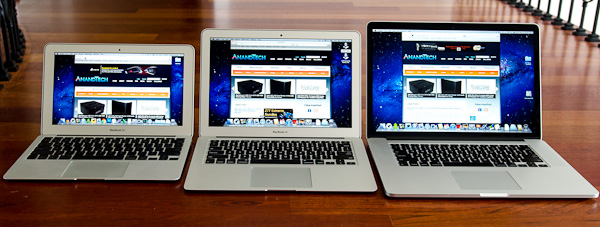
From left to right: 11-inch MacBook Air, 13-inch MacBook Air, MacBook Pro with Retina Display
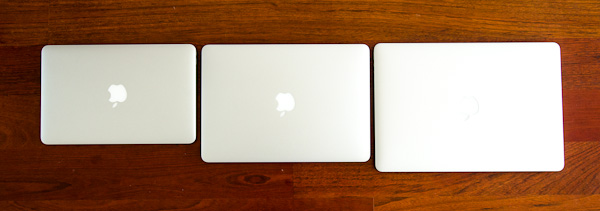
From left to right: 11-inch MacBook Air, 13-inch MacBook Air, MacBook Pro with Retina Display


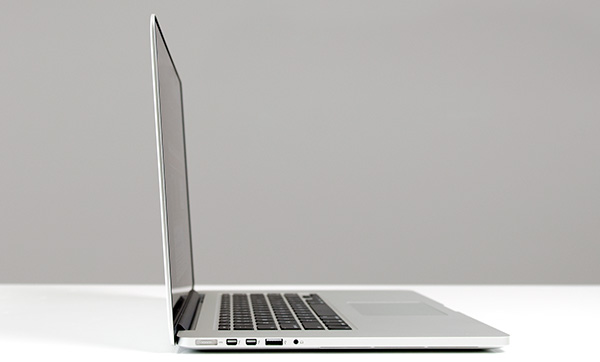
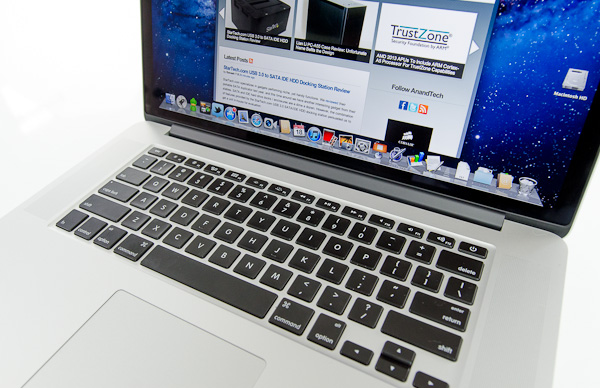
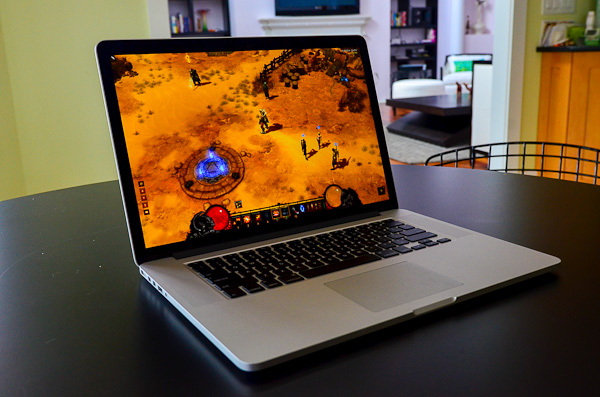
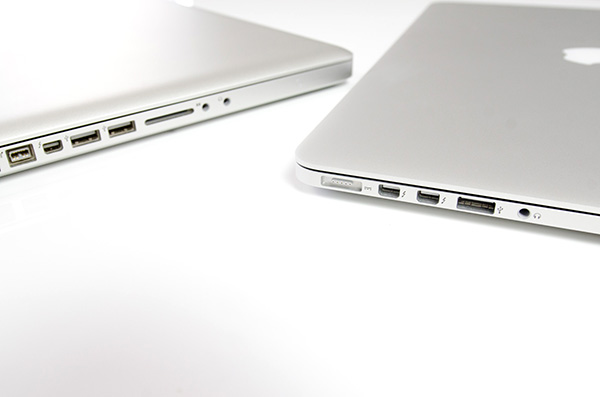
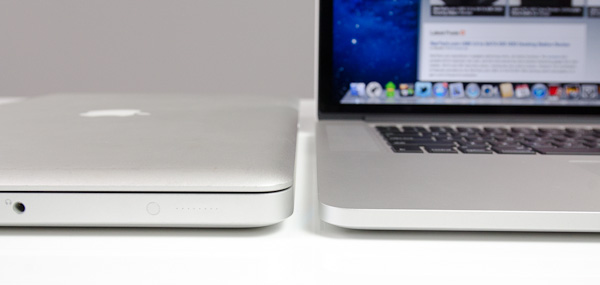








471 Comments
View All Comments
hyrule4927 - Sunday, June 24, 2012 - link
I did, and if Cinebench was pushing the same temperatures you saw in your test, then a lack of throttling is certainly not something to applaud. Nobody likes throttling, but it is certainly better than temperatures on the verge of thermal protection shutdown.jc@home - Sunday, June 24, 2012 - link
I am testing my rMBP for almost 1 hour so far via Prime95. Got some results below.• Environment: 28°C indoor beside window w/o air condition
rMBP via System Monitor (Mac App)
CPU@100% : 68~72°C
rMBP via DesktopMonitor or iStat
CPU Heatsink@100% : 53~56°C
GPU : 63°C
GPU Diode : 68~71°C
wfolta - Saturday, June 23, 2012 - link
I haven't read this anywhere else, but just stumbled onto it: In the Get Info window for an application, there is a checkbox that says "Open in Low Resolution". This box is checked for Pages, for example. Unchecking it clears up the text enormously. Why would the box be there and why is it checked for iWorks packages? (And is there any harm in unchecking it and getting clearer text?)EnerJi - Saturday, June 23, 2012 - link
Are the GUI elements still rendered at the same size or are they now half the size? I would expect them to be half size.wfolta - Saturday, June 23, 2012 - link
Oddly enough, in Pages the GUI icons are slightly larger. It's almost as if they simply had to throw that switch and the apps were already ready.I've noticed other apps, like Twitter, have the box checked but it's also greyed out so it can't be turned off.
tipoo - Sunday, June 24, 2012 - link
Do those have a dust filter or a metal mesh grille on them to prevent stuff getting sucked in? Hard to make that out in pictures, just curious. Also I'm curious if blocking them would raise the temperatures significantly, that was one of the things I liked about the MBP design vs bottom suckers, no worry of blocking airflow.wfolta - Sunday, June 24, 2012 - link
I can't see any screens from the outside, so I agree it's a little worrisome. Don't use it where dust or insects might get in. (And it does suck the air in through the vents, not out.)drwho9437 - Sunday, June 24, 2012 - link
Having been a reader since before the Athlon was released, having learned the pencil trick at Ace's in those days, I am saddened by the cool-aid style of the Apple articles as of late. As a regular Apple user I think Anand should co-write these with someone who is not to reduce the subjectivity.While I appreciate IPS and higher resolution. For instance we did not see a 17 page piece on the X220 for its IPS display, all be it a lower resolution one, nor the ability to have SSD + a mechanical disc at 3 lbs or run for massively more than a full work day.
Thunderbolt is neat, but like Firewire it could well be killed by USB 3's legacy and ubiquitous nature. For instance in the mass market most people aren't going to have a PC like monitor with cards in it, because most people don't buy any upgrades to computers, they just buy computers. So while I like myself having PCIe over a cable on a technical level I don't see it being in high demand if it add cost, which such a fast transceiver does, if Intel chooses to put it in everything then it could become established, but assuming the card statement is true most people would have to plug in 3 wires rather than 2 to "dock" (USB 3 -> Hub; power; monitor).
I guess what I am saying is that articles that make statements like "Apple is successful because its competitors have all been selfishly focused on themselves rather than all coming together to build better computers", which are just opinions are rather pointless, everyone has an opinion. My opinion is Apple's success speaks to the shallowness of people, form over function. The premium price as seen in this latest release allows them to load their products with all the latest stuff but at a price that makes it a BMW and not a Toyota. Are BMWs good cars? Yes. Does their price meet their performance? No. Visit Top Gear UK's review of the BMW 3 series, where they pointed out that BMWs were now more common than the comparable Ford. The point is the popularity was brand driven and that society still thinks it is cool, but when everyone has one, when Apple's market cap is larger than Microsoft's when will people realize there isn't anything exclusive about the brand anymore?
The reasons I make these points is not because I dislike Apple (beyond their closed nature), but because I strongly feel that if it didn't say Apple this review would have read:
Its a great screen but 2200 dollars is a lot for a screen and one that doesn't work properly with all software yet on the market. Add to that that you can't upgrade the laptop and it has no customizable options, and we think you may wish to wait (as per all the tablet/cell reviews) until these resolution panels are adopted across the market.
Though perhaps I am biased myself, I couldn't in good conscious give an award to something that I can't service, can't upgrade, and doesn't play well with anything but Apple software at the moment. I get the over all excitement, I've had nothing but IPS desktop displays for over 8 years, but yeah I can't help reading this as the review of a Nikon owner who's D700 just got upgraded to a D800, which is to say very shaded by the reviewer's familiarity and own desires for improvements.
wfolta - Sunday, June 24, 2012 - link
The Thinkpad X220 was in fact rated the best 12" business laptop, bar none. But it doesn't break any ground. The X220 is a great ultrabook, while the Retina Macbook Pro is a great laptop that they've managed to cram into an ultrabook form factor, including a display that no laptop made can match at any price. That's breaking ground, and perhaps deserves a longer review.You do realize that the rMPB is actually thinner than the X220 and only weighs 33% more, even though it's a 15" and has higher internal capacities, right? Once you pump up the X220 to be as comparable to the Retina Macbook Pro as possible, you've saved yourself 33% off of the rMBP, but you've also gotten half of the SSD, a smaller screen (physically and pixel-wise), fewer fast ports, the probable need for a dock, etc, etc.
The complaint about configuration was based on having two tiers of models instead of being continuously configurable from lowest to highest end. It doesn't mean the machine isn't configurable. You can upgrade the SSD, and you can order the rMBP with twice the RAM that the X220 is capable of holding.
"Doesn't play well with anything" is a ridiculous statement, when what you evidently mean is that some software is not optimized for it. "Can't service" is also ridiculous: if it breaks you can get it fixed.
If you want to say, "Hey, for 1/3 less money, I can get a mostly-smaller laptop that is lighter, has better battery life, a pretty amazing screen, and a CPU that's comparable", feel free. But you went way over the top and lost your case along the way.
vision33r - Sunday, June 24, 2012 - link
Very few folks in the tech biz today that aren't biased. Anand delivers another unbiased review of a remarkable device.I know very few of your readers here have nice things to say about Apple but all I can say is most of the folks are just extremely envious and zealous of Apple.
There is not one other company out there that is as focused as Apple and the sad part is their focus on consumer devices makes them seem like they only cater to avg Joes but their designs are really cream of the crop.
It's all in the details where it really matters unlike all the other PC guys that are just doing numbers and spec sheet battles of trivial specs.
In the end, most consumer that walk in the Apple store will see one and want one.
All other PC mfg will just copy, copy, and copy... it's the sad truth but it's fine. Competition is good.